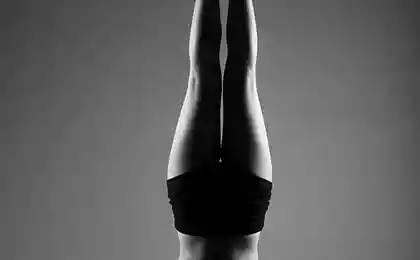756
Yoga for women — health and beauty
Eighty six million three hundred twelve thousand eight hundred forty five
The idea of women's health was different at different times in history in different societies and depended on cultural characteristics, economic conditions, scientific or religious ideas of the time. I must say that science, in the modern sense of the word, began to develop only after the Renaissance. But this does not mean that people living in, say, Ancient India or Egypt, there was no concept of women's health. If modern science is of great importance for experience as experiment, in the ancient society in the first place put experience as the accumulation and transmission of knowledge from generation to generation.
The health of any person is composed of several factors:
After learning the circumstances of his birth and early childhood, you will get the opportunity to work with this information to understand and accept the reasons for any problems. Now let's see what affects health and why it is so “rejuvenated” different diseases, once considered diseases of old age? Why less children are born healthy? Why happy and calm people are becoming less? Unnatural, induced conception; medication during pregnancy; drug and other intervention in the birth process; wrong behavior of the mother (or whoever replaces her) in relation to the child in the first year of life; the absence of continued breastfeeding; intoxication in childhood and adolescence (vaccinations, chemicals, radioactivity) – all affect our lives – like health, and mental and social well-being.
Scatenare women's health is primarily the implementation of the life cycle, ordained by nature: childhood, menstruation, growing up, motherhood, maturity and peaceful old age. But this does not mean that every woman must have children. In any society have always been women, not able to bear children. However, they did not feel deprived and miserable, because, living in large families, could care for the children of their relatives, fulfilling a maternal instinct.
Each period a woman's life requires special attention and understanding. Yoga practice should also be built in accordance with a particular stage. It so happened that in modern society women expect that she will be forever young and energetic, devoting all his time to the entertainment and career. And even the birth of a child has little effect on her lifestyle and appearance. She "notices" of menstruation and not experiencing any difficulties in the gym, because uses tampons. Lead an active sexual life and is not limited, as hormonal contraceptives. And even delay the menopause indefinitely now in its power: the doctor can find the hormonal drugs that will not allow this to happen "tragedy". But age still prevails, despite the emergence of new technologies in the cosmetic industry.
However, it is natural that motherhood changes a woman, her Outlook, way of life and view of themselves. During menstruation should rest and take care of yourself, because in this period, the body loses energy. We must learn to accept age-related changes, because hormone therapy – however, like hormonal contraception – never goes unnoticed.

Women's logictec what should be practice in different periods of life? And what is it all about yoga for women? Based on my twenty years experience of yoga practice, watching women of different ages, living in different countries and doing yoga, I can confidently say: the philosophy and practice of yoga, in the form in which it came to the modern Western person, is primarily yoga for men. In the context of women's practice, she requires some adaptation. A huge contribution to the development of yoga for women made Geeta S. Iyengar, the daughter of world-renowned guru, Sri B. K. S. Iyengar. She made it the theme of life, and recommendations that you will find in this article, based on her experience.
Women's practice must differ from men in the strength of the morphological and physiological characteristics, which can not be ignored. Women's body created with the purpose of procreation. Women have a wider pelvis, long waist, shorter legs, more flexible. Hormonal fluctuations in women are more pronounced and different from men. Therefore, recommendations to perform the same asanas for men and women can be different. The program of study women have to line up depending on the menstrual cycle. During menstruation, pregnancy, after birth and in menopause should be addressed by a special program. From the point of view of the philosophy of life, if men practice yoga can become a kind of professional realization and to stand in the first place, then for women a full immersion into yoga will be more substitution of some simple natural things: love, family, children, the importance of loved ones, etc. among other things, the General nature of practices should vary depending on age.
Young godiv youth practice should be intense and active. You need to move more and use a minimum of auxiliary materials. Of course, the correct performance of the asanas significantly, but when you're 15-20 years, it is more important just to move, to try to do difficult asanas, jump in Surya Namaskar, standing on the hands, perform standing poses dynamic and not fix them for long. This practice is reminiscent of the lesson with the children. As a rule, pranayama and meditation in this age, not really go because the mind is more directed outward. But in small quantities, these practices are also useful. During menstruation you need to engage in a special program or not engage at all.
The Golden age Seredina desire to engage very actively and dynamically usually disappears. It is quite natural, because the hormonal changes. At this stage of the life lessons you need to build depending on the monthly cycle. During menstruation is to carry out a special program, and in the first week after graduation – to engage actively. During ovulation (mid cycle) and continue, until the next menstrual period, should focus on asanas that are particularly beneficial to women: standing poses with support, poses at the opening of the pelvis (the Baddha Konasana, Upavista of Konasana, Supta Padangusthasana, Jana Sirsasana), variations in the inverted poses and backbends on the pole.
This does not mean that you need to completely exclude from the practice of the power of asana (for example, Ashtavakrasana or Visvamitra). But you have to monitor their condition and understand that any super can be bad for your health. By the way, this applies not only to the practice of yoga. First and foremost, must remember that women who have some gynecological diseases.
VSPackages Mature woman must learn to understand and accept age-related changes – physiological and psychological – which are beginning to occur in the 45-55 years. The time of onset of menopause depends on many factors: heredity, duration of breast feeding, climatic conditions and other. Yoga practice is unlikely to significantly delay this time, because the biological clock already started. But correct, balanced classes can help to get through this period without much deterioration and emotional breakdowns. At this time you need to engage in a special program. How much it will be differ depends on overall health, being female and level of practice. You can do all standing poses with support, to do backbends on a pedestal and poses for opening the chest, perform pranayama and meditate.
Technical prichinam the time of menstruation a woman needs more rest.
If you are just beginning to practice yoga, it is better not to go at this time in regular class and study at home according to a special program or lessons for women. This requirement is especially important to complete in the first three days of menstruation and strictly gynecological diseases. If you practice long enough to know how to work in the pose so as not to strain, it is possible to come to a normal class and to deal with all along, except for those positions at that period forbidden to do (inverted, abdominal, twisting, active backbends, jumps and difficult balance).
On dvoechka only a woman got pregnant, she should go to class with a special program – do not engage as if nothing has changed. You should avoid all poses, the execution of which is accompanied by tension, forward bends and any regulations which squeezed the abdomen or decreases the space between the thorax and the pelvis. Especially in the first trimester of pregnancy it is better to perform more postures for the back, such as Baddha Supta of Konasana. Useful also, inverted postures, with support, for example Sarvangasana with a chair and Viparita karani Mudra. Proper practices during pregnancy, normalizes hormonal system, helps women to adapt to physical changes and emotional state. Helps reduce swelling, good health, strengthens the back, which is very important during pregnancy and after birth. Promotes normal parturition (after birth is a hormonal process), and also has a positive effect on the child, reduces the likelihood of fetal hypoxia.
It is also good to perform pranayama in a semi-sitting position. It helps to calm the mind. Later, during labor, during labor, the ability to control breathing and state of mind helps to calm down. Special emphasis on inverted poses. Their performance during pregnancy is very important, but to be done under the guidance of an experienced teacher. For the first time after delivery (1.5 months) it is better not to do yoga and spend time with the child. In the postpartum period should avoid poses at the opening of the pelvis, jumping, intense forward bends and back. It is very useful to perform the postures at the poles, a variation of Adho Mukha Svanasana with feet elevated and inverted postures. All of this will help return internal organs after childbirth to its normal condition. But most importantly, helps return internal organs to normal, is breast-feeding.
Author: Elena Ulmasova
Source: yogajournal.ru/practice/real-target/4046/
The idea of women's health was different at different times in history in different societies and depended on cultural characteristics, economic conditions, scientific or religious ideas of the time. I must say that science, in the modern sense of the word, began to develop only after the Renaissance. But this does not mean that people living in, say, Ancient India or Egypt, there was no concept of women's health. If modern science is of great importance for experience as experiment, in the ancient society in the first place put experience as the accumulation and transmission of knowledge from generation to generation.
The health of any person is composed of several factors:
- heredity;
- everything that happens during the mother's pregnancy, birth and the first 3 years of life;
- education and living conditions in childhood;
- conditions and lifestyle at the moment.
After learning the circumstances of his birth and early childhood, you will get the opportunity to work with this information to understand and accept the reasons for any problems. Now let's see what affects health and why it is so “rejuvenated” different diseases, once considered diseases of old age? Why less children are born healthy? Why happy and calm people are becoming less? Unnatural, induced conception; medication during pregnancy; drug and other intervention in the birth process; wrong behavior of the mother (or whoever replaces her) in relation to the child in the first year of life; the absence of continued breastfeeding; intoxication in childhood and adolescence (vaccinations, chemicals, radioactivity) – all affect our lives – like health, and mental and social well-being.
Scatenare women's health is primarily the implementation of the life cycle, ordained by nature: childhood, menstruation, growing up, motherhood, maturity and peaceful old age. But this does not mean that every woman must have children. In any society have always been women, not able to bear children. However, they did not feel deprived and miserable, because, living in large families, could care for the children of their relatives, fulfilling a maternal instinct.
Each period a woman's life requires special attention and understanding. Yoga practice should also be built in accordance with a particular stage. It so happened that in modern society women expect that she will be forever young and energetic, devoting all his time to the entertainment and career. And even the birth of a child has little effect on her lifestyle and appearance. She "notices" of menstruation and not experiencing any difficulties in the gym, because uses tampons. Lead an active sexual life and is not limited, as hormonal contraceptives. And even delay the menopause indefinitely now in its power: the doctor can find the hormonal drugs that will not allow this to happen "tragedy". But age still prevails, despite the emergence of new technologies in the cosmetic industry.
However, it is natural that motherhood changes a woman, her Outlook, way of life and view of themselves. During menstruation should rest and take care of yourself, because in this period, the body loses energy. We must learn to accept age-related changes, because hormone therapy – however, like hormonal contraception – never goes unnoticed.

Women's logictec what should be practice in different periods of life? And what is it all about yoga for women? Based on my twenty years experience of yoga practice, watching women of different ages, living in different countries and doing yoga, I can confidently say: the philosophy and practice of yoga, in the form in which it came to the modern Western person, is primarily yoga for men. In the context of women's practice, she requires some adaptation. A huge contribution to the development of yoga for women made Geeta S. Iyengar, the daughter of world-renowned guru, Sri B. K. S. Iyengar. She made it the theme of life, and recommendations that you will find in this article, based on her experience.
Women's practice must differ from men in the strength of the morphological and physiological characteristics, which can not be ignored. Women's body created with the purpose of procreation. Women have a wider pelvis, long waist, shorter legs, more flexible. Hormonal fluctuations in women are more pronounced and different from men. Therefore, recommendations to perform the same asanas for men and women can be different. The program of study women have to line up depending on the menstrual cycle. During menstruation, pregnancy, after birth and in menopause should be addressed by a special program. From the point of view of the philosophy of life, if men practice yoga can become a kind of professional realization and to stand in the first place, then for women a full immersion into yoga will be more substitution of some simple natural things: love, family, children, the importance of loved ones, etc. among other things, the General nature of practices should vary depending on age.
Young godiv youth practice should be intense and active. You need to move more and use a minimum of auxiliary materials. Of course, the correct performance of the asanas significantly, but when you're 15-20 years, it is more important just to move, to try to do difficult asanas, jump in Surya Namaskar, standing on the hands, perform standing poses dynamic and not fix them for long. This practice is reminiscent of the lesson with the children. As a rule, pranayama and meditation in this age, not really go because the mind is more directed outward. But in small quantities, these practices are also useful. During menstruation you need to engage in a special program or not engage at all.
The Golden age Seredina desire to engage very actively and dynamically usually disappears. It is quite natural, because the hormonal changes. At this stage of the life lessons you need to build depending on the monthly cycle. During menstruation is to carry out a special program, and in the first week after graduation – to engage actively. During ovulation (mid cycle) and continue, until the next menstrual period, should focus on asanas that are particularly beneficial to women: standing poses with support, poses at the opening of the pelvis (the Baddha Konasana, Upavista of Konasana, Supta Padangusthasana, Jana Sirsasana), variations in the inverted poses and backbends on the pole.
This does not mean that you need to completely exclude from the practice of the power of asana (for example, Ashtavakrasana or Visvamitra). But you have to monitor their condition and understand that any super can be bad for your health. By the way, this applies not only to the practice of yoga. First and foremost, must remember that women who have some gynecological diseases.
VSPackages Mature woman must learn to understand and accept age-related changes – physiological and psychological – which are beginning to occur in the 45-55 years. The time of onset of menopause depends on many factors: heredity, duration of breast feeding, climatic conditions and other. Yoga practice is unlikely to significantly delay this time, because the biological clock already started. But correct, balanced classes can help to get through this period without much deterioration and emotional breakdowns. At this time you need to engage in a special program. How much it will be differ depends on overall health, being female and level of practice. You can do all standing poses with support, to do backbends on a pedestal and poses for opening the chest, perform pranayama and meditate.
Technical prichinam the time of menstruation a woman needs more rest.
If you are just beginning to practice yoga, it is better not to go at this time in regular class and study at home according to a special program or lessons for women. This requirement is especially important to complete in the first three days of menstruation and strictly gynecological diseases. If you practice long enough to know how to work in the pose so as not to strain, it is possible to come to a normal class and to deal with all along, except for those positions at that period forbidden to do (inverted, abdominal, twisting, active backbends, jumps and difficult balance).
On dvoechka only a woman got pregnant, she should go to class with a special program – do not engage as if nothing has changed. You should avoid all poses, the execution of which is accompanied by tension, forward bends and any regulations which squeezed the abdomen or decreases the space between the thorax and the pelvis. Especially in the first trimester of pregnancy it is better to perform more postures for the back, such as Baddha Supta of Konasana. Useful also, inverted postures, with support, for example Sarvangasana with a chair and Viparita karani Mudra. Proper practices during pregnancy, normalizes hormonal system, helps women to adapt to physical changes and emotional state. Helps reduce swelling, good health, strengthens the back, which is very important during pregnancy and after birth. Promotes normal parturition (after birth is a hormonal process), and also has a positive effect on the child, reduces the likelihood of fetal hypoxia.
It is also good to perform pranayama in a semi-sitting position. It helps to calm the mind. Later, during labor, during labor, the ability to control breathing and state of mind helps to calm down. Special emphasis on inverted poses. Their performance during pregnancy is very important, but to be done under the guidance of an experienced teacher. For the first time after delivery (1.5 months) it is better not to do yoga and spend time with the child. In the postpartum period should avoid poses at the opening of the pelvis, jumping, intense forward bends and back. It is very useful to perform the postures at the poles, a variation of Adho Mukha Svanasana with feet elevated and inverted postures. All of this will help return internal organs after childbirth to its normal condition. But most importantly, helps return internal organs to normal, is breast-feeding.
Author: Elena Ulmasova
Source: yogajournal.ru/practice/real-target/4046/























